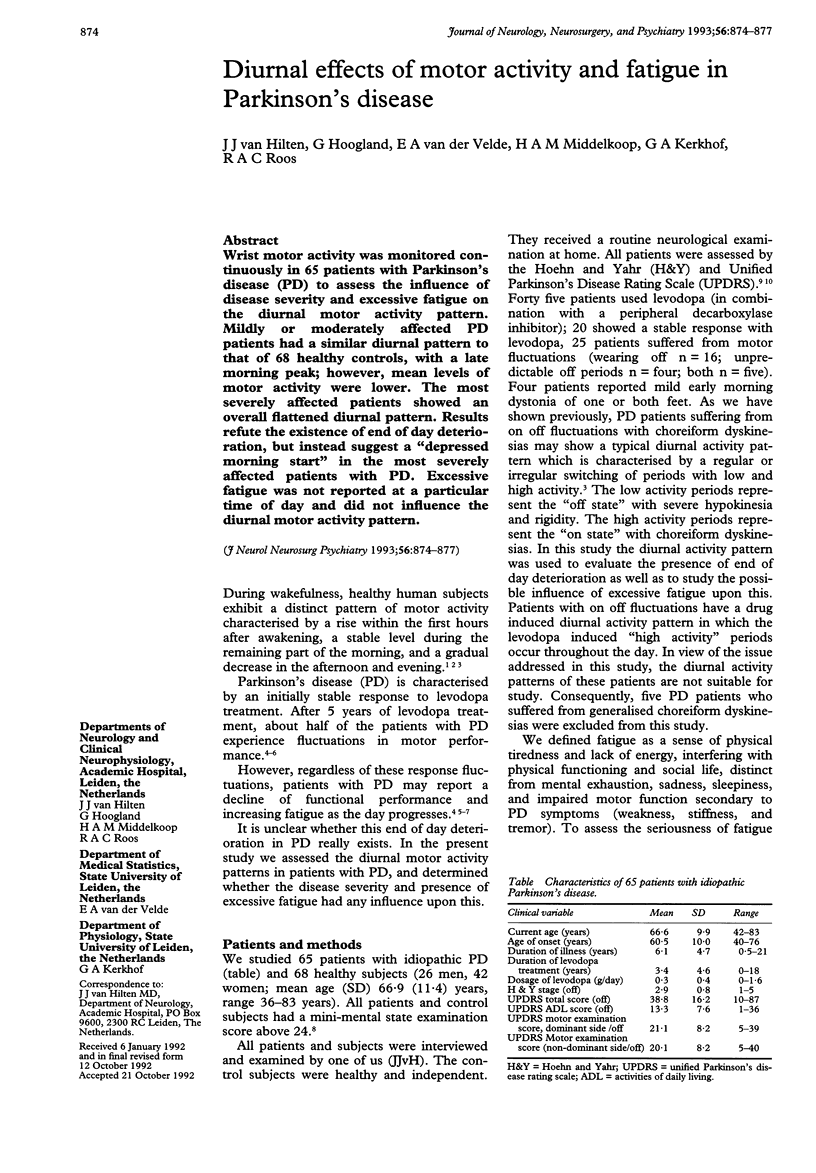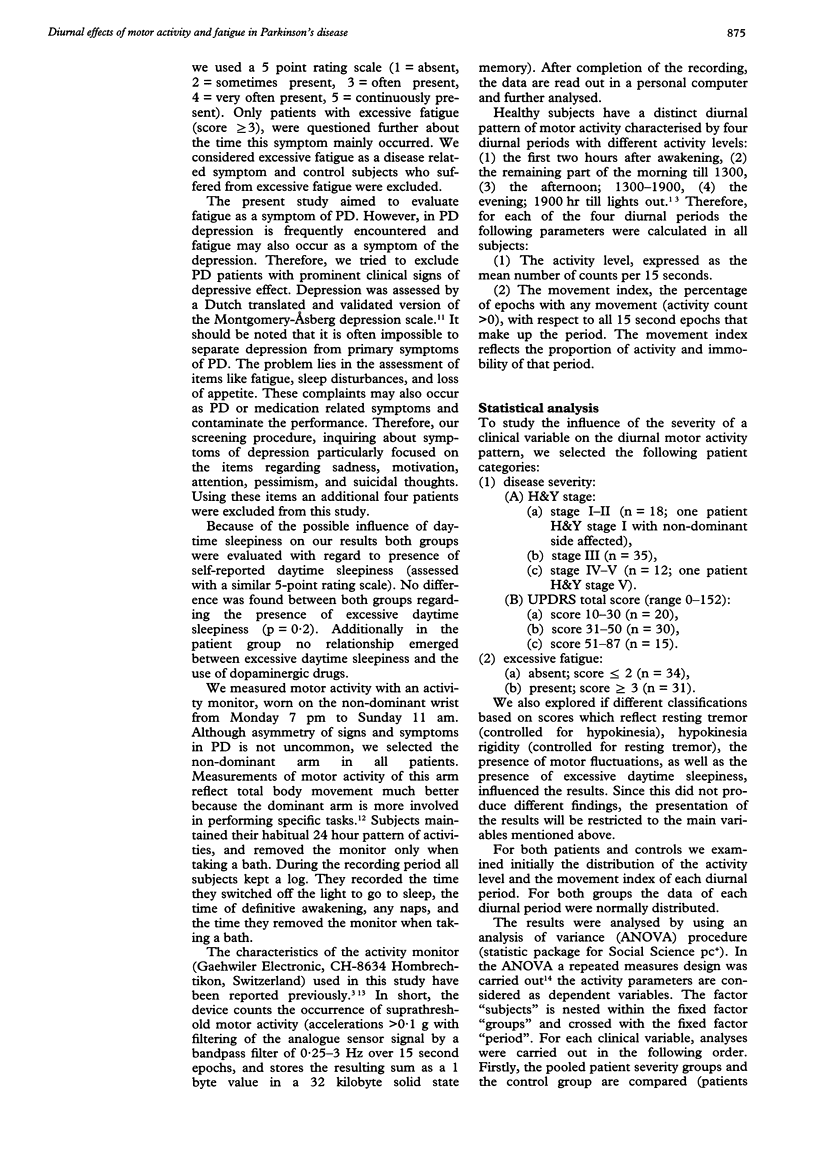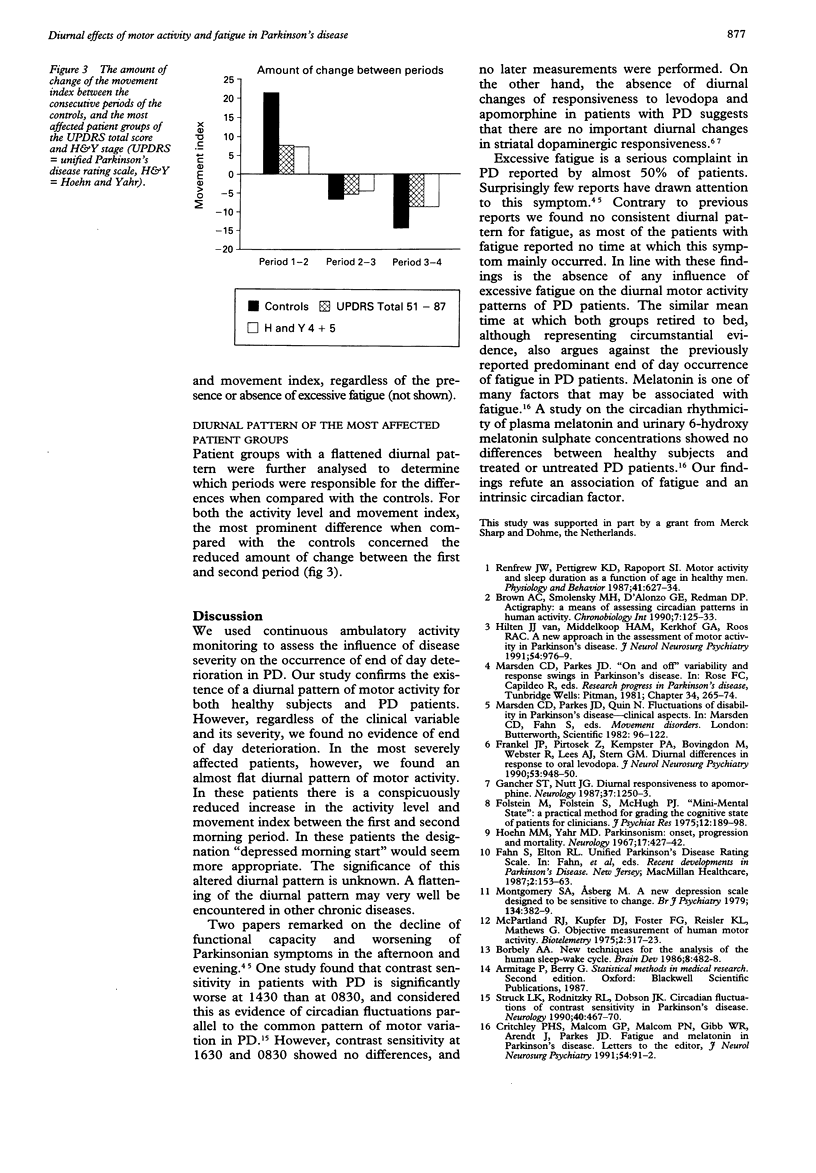Abstract
Wrist motor activity was monitored continuously in 65 patients with Parkinson's disease (PD) to assess the influence of disease severity and excessive fatigue on the diurnal motor activity pattern. Mildly or moderately affected PD patients had a similar diurnal pattern to that of 68 healthy controls, with a late morning peak; however, mean levels of motor activity were lower. The most severely affected patients showed an overall flattened diurnal pattern. Results refute the existence of end of day deterioration, but instead suggest a "depressed morning start" in the most severely affected patients with PD. Excessive fatigue was not reported at a particular time of day and did not influence the diurnal motor activity pattern.
Full text
PDF



Selected References
These references are in PubMed. This may not be the complete list of references from this article.
- Borbély A. A. New techniques for the analysis of the human sleep-wake cycle. Brain Dev. 1986;8(4):482–488. doi: 10.1016/s0387-7604(86)80073-0. [DOI] [PubMed] [Google Scholar]
- Brown A. C., Smolensky M. H., D'Alonzo G. E., Redman D. P. Actigraphy: a means of assessing circadian patterns in human activity. Chronobiol Int. 1990;7(2):125–133. doi: 10.3109/07420529009056964. [DOI] [PubMed] [Google Scholar]
- Folstein M. F., Folstein S. E., McHugh P. R. "Mini-mental state". A practical method for grading the cognitive state of patients for the clinician. J Psychiatr Res. 1975 Nov;12(3):189–198. doi: 10.1016/0022-3956(75)90026-6. [DOI] [PubMed] [Google Scholar]
- Frankel J. P., Pirtosek Z., Kempster P. A., Bovingdon M., Webster R., Lees A. J., Stern G. M. Diurnal differences in response to oral levodopa. J Neurol Neurosurg Psychiatry. 1990 Nov;53(11):948–950. doi: 10.1136/jnnp.53.11.948. [DOI] [PMC free article] [PubMed] [Google Scholar]
- Gancher S. T., Nutt J. G. Diurnal responsiveness to apomorphine. Neurology. 1987 Jul;37(7):1250–1253. doi: 10.1212/wnl.37.7.1250. [DOI] [PubMed] [Google Scholar]
- Hoehn M. M., Yahr M. D. Parkinsonism: onset, progression and mortality. Neurology. 1967 May;17(5):427–442. doi: 10.1212/wnl.17.5.427. [DOI] [PubMed] [Google Scholar]
- McPartland R. J., Kupfer D. J., Foster F. G., Reisler K. L., Matthews G. Objective measurement of human motor activity: a preliminary normative study. Biotelemetry. 1975;2(6):317–323. [PubMed] [Google Scholar]
- Montgomery S. A., Asberg M. A new depression scale designed to be sensitive to change. Br J Psychiatry. 1979 Apr;134:382–389. doi: 10.1192/bjp.134.4.382. [DOI] [PubMed] [Google Scholar]
- Renfrew J. W., Pettigrew K. D., Rapoport S. I. Motor activity and sleep duration as a function of age in healthy men. Physiol Behav. 1987;41(6):627–634. doi: 10.1016/0031-9384(87)90321-0. [DOI] [PubMed] [Google Scholar]
- Struck L. K., Rodnitzky R. L., Dobson J. K. Circadian fluctuations of contrast sensitivity in Parkinson's disease. Neurology. 1990 Mar;40(3 Pt 1):467–470. doi: 10.1212/wnl.40.3_part_1.467. [DOI] [PubMed] [Google Scholar]
- van Hilten J. J., Middelkoop H. A., Kerkhof G. A., Roos R. A. A new approach in the assessment of motor activity in Parkinson's disease. J Neurol Neurosurg Psychiatry. 1991 Nov;54(11):976–979. doi: 10.1136/jnnp.54.11.976. [DOI] [PMC free article] [PubMed] [Google Scholar]


